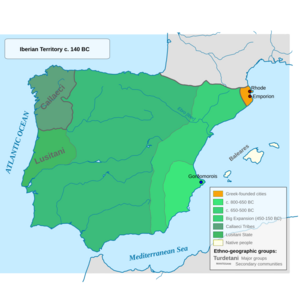Proto-Iberian: Difference between revisions
(Created page with "{{Private}} {{Infobox language |name=Proto-Iberian |nativename=Dankwā/Ibērom |pronunciation={{IPA|/ˈdan.kwaː/}} |creator=Iohanen |setting=Iberia |ethnicit...") |
mNo edit summary |
||
| Line 156: | Line 156: | ||
|oːw | |oːw | ||
|} | |} | ||
[[Category:Conlangs]] | |||
Revision as of 23:44, 2 September 2022
This article is private. The author requests that you do not make changes to this project without approval. By all means, please help fix spelling, grammar and organisation problems, thank you. |
| Proto-Iberian | |
|---|---|
| Dankwā/Ibērom | |
| Pronunciation | [/ˈdan.kwaː/] |
| Created by | Iohanen |
| Setting | Iberia |
| Ethnicity | East Iberians/Graeco-Iberians |
Indo-European
| |
The borders of the Iberian Empire | |
The Proto-Iberian language is the reconstructed ancestor proto-language of the Iberian branch of the Indo-European languages. The Proto-Iberian language presumably had begun to separate from the Proto-Indo-European language in the 1st millenia to 5th century BC, becoming a proper language in the mid of the 7th century BC.
The Iberians as an ethnicity are known to have appeared as a very small group of tribes in East Iberia that later united and expanded to the entirety of Iberia (that would later result into two distinct languages) within the centuries. Its vocabulary is almost entirely derived from Proto-Indo-European with exceptions of late borrowings from Ancient Greek and, sometimes, Latin.
Terminology
The language name derives itself from an Ancient Greek reborrowing that comes from the River Ibēr (actual River Ebro in Spain), named by the Celtici.
History
This article is a construction site. This project is currently undergoing significant construction and/or revamp. By all means, take a look around, thank you. |
The Iberian peoples are an Indo-European people that first appeared during the Atlantic Bronze Age, migrating from the Southwest of modern France to the Southeast of Iberia. There, they developed into many divided tribes who would later - with the arrival of the Ancient Greeks and their contact with them - reunite into a single tribe ruled by a so called Teutārēks (a leader similar to a king without leadership of the army). Their territory was about the same until the arrival of the Ancient Greeks in Emporion.
When the Greeks arrived and founded the cities of Rhode and Emporion, the Iberians had already expanded into the region and thereafter established commercial relations with them. As the time passed and the contact became stronger, the Iberians adopted Greek technologies (state and army organization, philosophy, capital, etc.), including their alphabet, and parts of culture/religion (architecture, gods, statues). After about 100 years of direct contact (c. 480 BC), the Greeks were integrated into the new Iberian state, though the contact with Massalia was kept and Emporion and Rhode became the main commercial centres in Iberia.
With the new concepts adopted from the Greeks, the Iberians seeked to expand westwards to gather more resources and comercialize them (mostly with Greeks and Romans). The tribes located in the center of Iberia were quickly dominated as they had a similar culture and language as the Iberians. While expandind westwards, they found the bellicose tribes of the Callaeci and Lusitani, which resisted against their control. After years of war, the Lusitani had accepted a truce as being a state under Iberian control, holding total state autonomy while having to provide soldiers or army supplies if needed. The Callaeci still resisted until much after.
At the start of the 1st century AC, the Proto-Iberian language had already started to diverge into more languages. The reason for its late preservation is the fact that it was, at early, an isolated language compared to other European languages.
Romanization
Romanizing is pretty straightforward, there are only 5 vowels (all of which have long variants) and 17 consonants that are one-to-one correspondences totalizing 27 letters.
| Romanization of Proto-Iberian | ||||||||||||||||||||||||||
|---|---|---|---|---|---|---|---|---|---|---|---|---|---|---|---|---|---|---|---|---|---|---|---|---|---|---|
| Aa | Āā | Bb | Dd | Ðð | Ee | Ēē | Ff | Gg | Ii | Īī | Jj | Kk | Ll | Mm | Nn | Oo | Ōō | Pp | Rr | Ss | Tt | Uu | Ūū | Vv | Ww | Zz |
Phonology
Consonants
| Labial | Dental | Alveolar | Palatal | Velar | Labial-velar | |
|---|---|---|---|---|---|---|
| Nasal | m | n | ||||
| Stop | p b | t d | k g | kʷ ɡʷ | ||
| Fricative | f v | ð (θ) | s z | |||
| Approximant | j | w | ||||
| Lateral | l | |||||
| Trill | r | |||||
- [θ] is an allophone of [ð] on initial position.
- [z] appears in between vowels and only in native words of Proto-Indo-European origin. It can be sometimes considered an allophone of [s] before a nasal. Example: *auzom ("gold")
Vowels
| Front | Central | Back | |
|---|---|---|---|
| Close | i iː | u uː | |
| Mid | e eː | o oː | |
| Open | ä äː |
- At a later stage of the language, [i] could be realized as [ɪ].
Diphthongs
| -i/j | -u/w | ||||
|---|---|---|---|---|---|
| a- | ā- | aj | aːj | aw | aːw |
| e- | ē- | ej | eːj | ew | eːw |
| o- | ō- | oj | oːj | ow | oːw |




